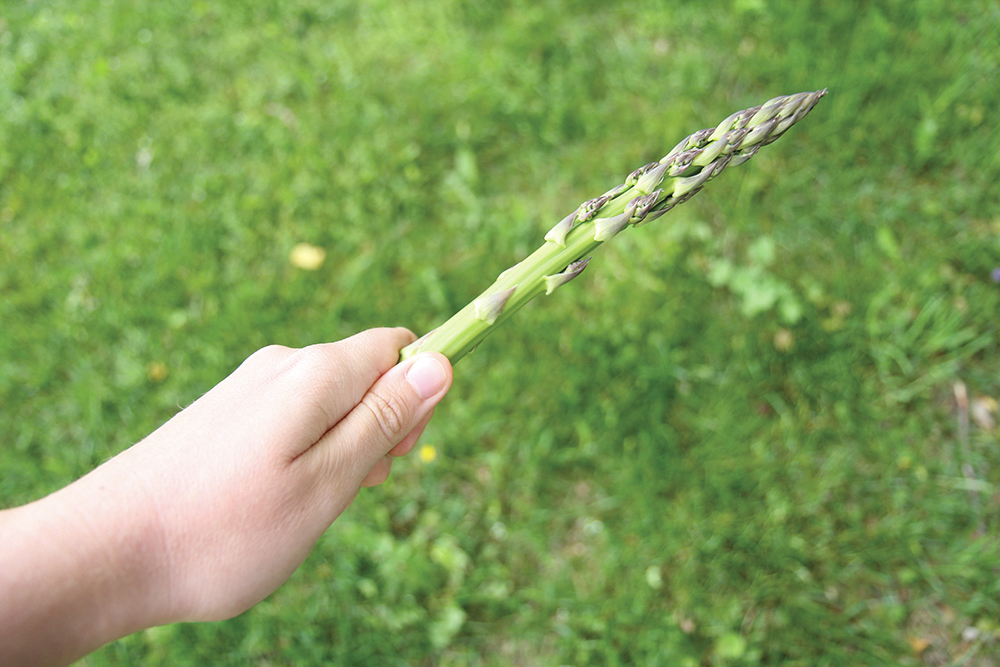Choo-choo!
By Linda Hepler Beaty
Current Contributor
One of the first harbingers of spring in the veggie world is asparagus, a popular early farmers’ market pick. Fortunately for those of us in Benzie County, there are quite a few asparagus farmers along our northern border that are already well underway for spring production. Whether you prefer the U-pick option at the Norconk Asparagus Farm—between Empire and Honor, very close to the Benzie-Leelanau county line—or the pre-bundled option at the iconic wooden Harris Farm stand, which stands under a shady grove of trees on Indian Hill Road near Honor, there is plenty of asparagus to be had in our neck of the woods.
People are so enthusiastic about this spring staple that they begin inquiring about availability as early as April, says third-generation farmer Harry Norconk, who, along with wife Barbara, owns Norconk Asparagus Farm.
“When you get a sunny day, about 50 degrees, people start calling to ask when the asparagus will be ready,” he says.
But while there is no hard-and-fast rule, you will not see asparagus in Northern Michigan until it reaches about 70 degrees and the calendar flips to May, he adds.
“The season starts May 10, plus or minus 10 days, and it normally ends about June 25, plus or minus five days,” Norconk says.
Any earlier than that, and you are in for a disappointment, because asparagus that emerges through the ground on an isolated warm day in late April or very early May will not grow much taller once it cools down to a more seasonal 40 to 50 degrees, and by the time that it warms up again in mid-May and begins to grow taller, the spears can be tough. Another problem with an early season is the constant specter of frost, which renders the tender veggie to mush overnight. According to the National Climatic Data Center, the average last potential frost date for Frankfort is May 23, meaning that even once the asparagus season is underway, a farmer may still suffer a crop loss.
Fun Facts About Asparagus
Asparagus comes in three colors: green, purple, and white. White asparagus is simply green asparagus that is protected from the light and resulting photosynthesis that causes the green pigmentation.
Asparagus aficionados claim that different colors of asparagus taste differently; many say that purple asparagus is a bit sweeter than green and that white asparagus is milder and a bit more tender than the other colors.
While many prefer slim spears of asparagus, because they are perceived to be more tender, in actuality, thick spears are less fibrous with more tender pulp than thin spears. Moreover, slim spears may be more visually appealing, while thick ones hold up better to grilling.
Asparagus has very few calories and lots of vitamins, including vitamins K, B, C and E. It also contains zinc, iron, and lots of fiber.
The characteristic “asparagus odor” that is detectable in urine after consuming asparagus is due to the asparagusic acid in the veggie, which, when eaten, breaks down into sulfur-containing compounds.
Asparagus can be cooked in a variety of ways, including steaming, grilling and sautéing. It can be pureed and made into a pesto or shaved raw for a crunchy texture in salads or atop soups.
This year, the asparagus was up in early May.
“But just when it got to three or four inches, we got hammered with a frost; it was 23-24 degrees at night for two days,” Norconk says.
The result was a total loss of what would have been a first picking. But Norconk considers an early frost less devastating to the asparagus business than one later in the season.
“If you’re going to have frost,” he says, “it’s better to have it at the beginning of the season, when you can tell people ‘No, it’s not ready yet,’ than if we start delivering it, and then it frosts. When that happens, everyone is upset.”
The Mighty Asparagus
While asparagus is globally grown—China, Peru, and Germany are the highest producers worldwide, while California, Washington, and Michigan are the top producers in the nation—and universally loved, few people know much about its history or how it is farmed.
The flowering perennial was once classified in the lily family, like onions and garlic were, but onion-like plants have been moved into the Amaryllidaceae family and asparagus into their own Asparagaceae family. Asparagus is native to most of the western coasts of Europe (from northern Spain to Ireland, Great Britain, and northwest Germany), northern Africa, and western Asia. It has been cultivated and enjoyed both as a vegetable and a medicinal plant (some considered it an aphrodisiac) since the days of ancient Greece, Rome, and Egypt. It was the 15th century before asparagus began to be noticed in France and England, and it was introduced to the United States by the mid-19th century.
The spears emerge from a grouping of rhizomes, known as a rootstock or a crown, and the time from planting a year-old crown to full productivity is about three to four years. A field of asparagus can produce for about 15 years on average, says Norconk, and even longer in a less-crowded home garden.
Asparagus plants need a weed-free environment and lots of water and sun. Once the weather has warmed sufficiently, the spears can grow to full length (about nine inches) within 24 hours, and each plant can produce as many as 25 spears per season, making daily picking a necessity during the short growing period. The vegetable is hand picked, using an asparagus-picking cart, on which up to five people are seated low to the ground, bending forward to snap the asparagus at ground level as the cart passes over the rows. According to Norconk, the average asparagus season yields about 20 pickings, the first two or three a bit sparse, and the last few with smaller-diameter spears.
After the last harvest, the remaining spears that emerge are allowed to grow through the summer season, the stems reaching several feet high and resembling a large frilly fern. The tall plants produce carbohydrates and proteins, storing them underground, in the roots, for nourishment for the next season. They also produce fruit—a small red berry, which is poisonous to humans.
Norconk looks forward to a busy asparagus season in 2017, with distribution planned throughout Benzie, Leelanau, and Grand Traverse counties to grocery stores, restaurants, and farmers’ markets. Although you might think he and Barbara would become tired of asparagus after working with it every day for two months, he contends that they never get sick of eating it.
“We love to eat asparagus, in every way, shape, or form,” he chuckles. “Grilled, pan fried, whatever. But usually, we steam it—after a long day in the field, that’s fast and easy.”
Harris Family Farm Reopens
If you drove past the iconic wooden Harris Farm stand last spring or summer, you might have been surprised to have seen it empty. For many people, it was a tradition to stop there for the first spring asparagus and later for hydroponic tomatoes, European cucumbers, sweet corn, pumpkins, and more.
The farm operation, which began with Walt and Sharon Harris in 1979, came to a halt in September 2015, when Walt suffered a fatal heart attack while on vacation in Homer, Alaska, leaving behind his wife, two children, and three grandchildren, as well as many friends and family members.
“We took a year off,” says Sharon, who had been married to Walt for 40 years. By her own admission, she knew little about growing asparagus—though 15 acres of the Harris farm are devoted just to this veggie, not to mention the other produce—and so she briefly considered the idea of giving up the farm, but really did not want to do that.
“You don’t want to give up something that’s been a part of your life for so long,” she says.
After much thought and discussion with family members, Sharon turned the farm operation over to the couple’s son Matt (though she will help out, as needed). Prior to taking up farm operations, Matt had been taking some time off from his career as a mechanic and traveling. While Matt had grown up on the farm and helped his dad out during the growing season, he had not envisioned running the farm himself one day.
“I never thought in a million years I’d have to jump into crops like this,” says Matt, who is currently busy with the spring asparagus season, with plans to add sweet corn and pumpkins this year, and perhaps hydroponic tomatoes at a later date.
How does a mechanic learn how to be a farmer? Matt says that, at first, he did not know exactly where to start, but with the help of internet research, the Michigan State University Extension, and discussions with other farmers, he has learned enough to confidently begin the season. And while he does not expect that everything will run perfectly this year, he knows that he can try different approaches in the future to make things run smoother.
“Every farmer has a different opinion,” he adds, so there are many options to try.
Matt is realistic about the challenges of farming, including spring frosts and other weather issues, pests, trouble finding workers—and long hours.
“I would like a clone,” he says. “So that I could sleep. And spend more time with my son.”
Matt and his partner Penny’s baby, Walter, was born last September 5, almost a year after the death of the baby’s grandfather, Walt. And while Matt may regret being too busy to spend all of the time that he wants with his child, he believes that the farm is a great place to raise Walter.
“I had a lot of happy times here [as a kid], running all over the place,” Matt recalls.
The Harris family began picking asparagus last week, so stop by the little stand to get some. And if you see Matt, wish him well on his new adventures in father-dom and farming!
A version of this story first appeared in our sister publication, the Glen Arbor Sun. As of press time, Norconk expected to pick and sell his first batch of asparagus on Tuesday, May 16, three days before the Empire Asparagus Festival, which relies annually upon his yield.




